 Leading Blog | Posts by Month |
 Leading Blog | Posts by Month |
06.30.10

LeadershipNow 140: June 2010 Compilation
Posted by Michael McKinney at 09:32 AM
06.29.10

Multipliers: How the Best Leaders Make Everyone Smarter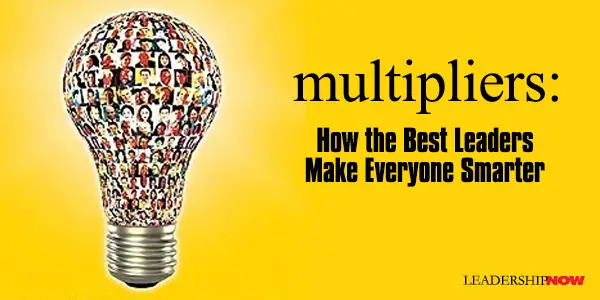
MUCH OF WHAT constitutes good leadership can be summarized in two words: respect and selflessness. How we relate to those two words will determine how we lead. Consider two assumptions that lie at the opposite ends of the spectrum: • Really intelligent people are a rare breed and I am one of the few really smart people. People will never be able to figure things out without me. I need to have all the answers. • Smart people are everywhere and will figure things out and get even smarter in the process. My job is to ask the right questions. What you believe has a big impact on the performance, engagement, loyalty and the transparency you find with those you lead and interact with. In Multipliers: How the Best Leaders Make Everyone Smarter, authors Liz Wiseman and Greg McKeown refer to those with the mindset represented by the first assumption as Diminshers and those with the mindset represented by the second assumption as Multipliers. It explains why some leaders create intelligence around them, while others diminish it. The value of Multipliers is that is shows what these assumptions about people look like in practice and how they are reflected in your behavior. How would you approach your job differently if you believed that people are smart and can figure it out? With a Multiplier mindset, people will surprise you. They will give more. You will learn more. What kind of solutions could we generate if you could access the underutilized brainpower in the world? How much more could you accomplish? It’s not that Diminishers don’t get things done. They do. It’s just that the people around them feel drained, overworked and underutilized. Some leaders seem to drain the “intelligence and capability out of the people around them. Their focus on their own intelligence and their resolve to be the smartest person in the room [has] a diminishing effect on everyone else. For them to look smart, other people had to end up looking dumb.” In short, Diminishers are absorbed in their own intelligence, stifle others, and deplete the organization of crucial intelligence and capability. Multipliers get more done by leveraging (using more) of the intelligence and capabilities of the people around them. They respect others. “Multipliers are leaders who look beyond their own genius and focus their energy on extracting and extending the genius of others.” These are not “feel good” leaders. “They are tough and exacting managers who see a lot of capacity in others and want to utilize that potential to the fullest.” The authors have identified five key behaviors or disciplines that distinguish Multipliers from Diminishers. You are not either/or but are somewhere along a continuum. These are all learned behaviors and have everything to do with how you view people. We don’t have to be great in all disciplines to be a Multiplier, but we have to be at least neutral in those disciplines we struggle with.
They have developed an assessment tool you can use to see where you are. Importantly, the first place to begin is with your assumptions about people. If you don’t have that straight the rest is just manipulation. As with most behaviors, we do them because we feel we have to. They are self-perpetuating. We jump in where we shouldn’t and come to the rescue. Under our “help” (domination) people hold back thereby reaffirming our belief that they just couldn’t do it without us. And they can’t or rather won’t. Instead they quit while still working for us or move on. We see this in ourselves, in others and in organizations of all types. Leaders are especially prone to run over people, because after all, they have the vision, the know-how and the desire to get it done. We have to slow down and remember that we are not there just to get the job done, but to develop others to get the job done. They can (and need to be able to) do it without us. It’s our job to show them how. In many ways, as leaders, we can become accidental Diminishers. The skills that got us into a position of leadership, are not the same skills we need to lead. Leadership requires a shift in our thinking. Wiseman and McKeown write, “Most of the Diminishers had grown up praised for their personal intelligence and had moved up the management ranks on account of personal—and often intellectual—merit. When they become ‘the boss,’ they assumed it was their job to be the smartest and to manage a set of ‘subordinates.’" Here are some thoughts—out of context—from the book that will get you thinking: “Marguerite is so capable she could do virtually any aspect of girl’s camp herself.” But what is interesting about Marguerite isn’t that she could—it is that she doesn’t. Instead, she leads like a Multiplier, invoking brilliance and dedication in the other fifty-nine leaders who make this camp a reality. One leader had a sign on her door: “Ignore me as needed to get your job done.” She told new staff members, “Yes, there will be a few times when I get agitated because I would have done it differently, but I’ll get over it. I’d rather you trust your judgment, keep moving, and get the job done.” The path of least resistance for most smart, driven leaders is to become a Tyrant. Even Michael said, “it’s not like it isn’t tempting to be tyrannical when you can.” Policies—established to create order—often unintentionally keep people from thinking. At best, these policies limit intellectual range of motion as they straitjacket the thinking of the followers. At worst these systems shut down thinking entirely. “It is just easier to hold back and let Kate do the thinking.” [They resign: “Whatever!”] It is a small victory to create space for others to contribute. But it is a huge victory to maintain that space and resist the temptation to jump back in and consume it yourself. An unsafe environment yields only the safest ideas. [Multipliers] ask questions so immense that people can’t answer them based on their current knowledge or where they currently stand. To answer these questions, the organization must learn. His greatest value was not his intelligence, but how he invested his intelligence in others. 
Posted by Michael McKinney at 04:28 PM
06.25.10

Finding the Why of WorkAs most of us spend more time at work than we do anywhere else, work is a universal setting in which we can find meaning in our life. Meaning is the why that motivates, inspires and defines us. The Why of Work by Dave and Wendy Ulrich is a timely and important book. It is about our search for meaning and how “leaders facilitate that search personally and among their employees.”Importantly, they begin with a discussion of the seemingly inevitable issue of deficit thinking. “When employees lose what they have come to count on and expect—be it a person, an income, a position, or less concrete notions like security, identity, or direction—they are inclined to deficit thinking.” “Deficit thinking,” they write, “can lock us into a prison of our own making, a prison dominated by fear, isolation, disorientation, and competition for scarce resources.” We can’t eliminate the hardships, uncertainties and disruptions we sometimes face, but we can change our perspective—find a different meaning. That is where leaders come in. If we focus attention on what we stand to gain from our crisis, not just what we stand to lose, abundance thinking can replace deficit thinking even when deficits are the rule of the day. Abundance looks to future opportunity more than past disappointments, promotes hope over despair, suggests change for the future rather than languishing in the past, and fosters the creation of new meaning where old meanings have broken down. Abundance does not imply that things come easily or quickly but that we can make meaning even in the midst of challenges we face.Leaders need to promote this meaning–making; create repositories of abundance where employees can “gain antidotes to some of the malaise, isolation and crises of meaning” they face. Meaning is not found in events but in the way we interpret those events. This means we are not (or should not) be controlled by what is happening around us, but that we have to consciously work to determine what it means. Dave and Wendy Ulrich have proposed seven questions—and devoted a chapter to each—to help leaders drive the abundance agenda—questions that help leaders make meaning, add value, create emotional energy, and foster hope while at work. 1. What Am I Known For? (Identity) A sense of identity is fostered by a clear sense of who we are, what we believe in, and what we are good at. Our identity is grounded in how we instinctively use our skills in the service of our deepest values. 2. Where Am I Going? (Purpose and Motivation) Abundance emerges from a clear sense of what we are trying to accomplish and why. Employees who can meet their personal goals at work remain motivated and engaged; those who can’t, go in a different direction, physically or emotionally. 3. Whom Do I Travel With? (Relationships and Teamwork) Our sense of abundance is enhanced by meaningful relationships. High-performing teams come from high-relating people. When leaders help their organization “families” move beyond superficialities of getting along to struggle through conflict so that they can understand one another’s strengths and weakness, they can approach the kind of synergy that occurs in the best of human relationships. This means that leaders need to learn and model the skills of building good relationships at work. 4. How Do I Build a Positive Work Environment? (Effective Work Culture or Setting) Abundance thrives on positive routines that help ground us in what matters most. Instead of building routines and patterns that encourage self-reflection, honest sharing, and the kind of consistency that brings people together, many of us build habits, addictions, and compulsive patterns that serve primarily to block out other people. Or, we build few routines at all, leaving us untethered in time and space and making us unpredictable to those who want to connect. Routines and patterns driven by our deepest values help us stay grounded in what matters most and available to those who matter most. 5. What Challenges Interest Me? (Personalizing and Contributing Work) It’s hard to imagine abundance in the absence of challenge. Employees who are competent but not committed will not perform to their full potential. Commitment comes from building an employee value proposition that engages employees to use their discretionary energy to pursue organization goals. Commitment or engagement grows when we work in a company with a vision, have opportunities to learn and grow, do work that has an impact, receive fair pay for work done, work with people we like working with, and are offered flexibility about terms and conditions of work. 6. How Do I Respond to Disposability and Change? (Growth, Learning, and Resilience) Abundance is less about getting things right and more about moving in the right direction. Unlike the assumption of disposability that governs so much of modern society, resilience and learning principles challenge us to “repair, reuse, and recycle” people, products, and programs rather than tossing them. 7. What Delights Me? (Civility and Happiness) Abundance thrives on simple pleasures. The cry for tolerance demands that we outgrow our racial, religious, political, ethnic, and gender stereotypes. The cry for civility also calls upon us to outgrow our we-they, win-lose, right-wrong, blame-and-shame mentality. As we move away from hostility and blame toward problem-solving, listening, curiosity, and compassion, simple civility greases the skids. Delight often comes in small packages, and when money is tight it helps to know that small and simple pleasures spread over time have more impact on our sense of well-being than grand one-time gestures. “Meaning does not ensure ease; it offers hope,” they write. “Abundance emerges from the growing conviction that what we are about ‘makes sense’—that it contributes to something larger than ourselves and that it is grounded in our deepest values. Such conviction does not forestall all problems, but it helps us confront problems with courage and integrity.” Leaders at all levels can help (and have a responsibility to) make meaning happen.
Posted by Michael McKinney at 12:00 AM
06.23.10

Developing a Small-Wins Strategy for GrowthWhen moving through difficult times, it is helpful to develop a small-wins strategy. In difficult times, deficit-thinking is so easy to fall into and often becomes the norm. It is hard to defeat but by highlighting small-wins you help to create the kind of abundance-thinking needed for growth and forward momentum. A strategy of small-wins helps to develop the kind of outlook associated with abundance-thinking—self-efficacy, hope, optimism and resilience.A small-wins strategy also helps to eliminate the tendency to be consumed by past disappointments, obstacles and failures. The need to look for “what is working now” is key to moving forward. It opens your thinking to possibilities and paves the way for improving processes. Small-wins focus on the here and now. What can we do now and what can we safely ignore or eliminate. It is an antidote to the fixation error trap. It’s easy to caught up in “everything”—the full impact of what is happening and the habits and perspectives that have become so much of who we are—that we become overwhelmed and unable to act at all. Fixation errors keep us from noticing what is really happening, separating us from reality. Reassess after each win and keep moving to build momentum. Begin by breaking tasks and issues down in to manageable pieces; pieces that you can take responsibility for and act on now. If you are not in a position to implement this strategy on an organizational level, adopt it for your team or even individually. Lead from where you are. It’s contagious. Of Related Interest:
Posted by Michael McKinney at 11:35 AM
06.22.10

12 Leadership Guidelines for Leading through Learning in Turbulent TimesIn January 2009, founder and chairman of India’s Satyam Computer Services—the “largest publically traded company you’ve never heard of”—Ramalinga Raju confesses to massive accounting fraud and resigns. In a five-page letter to the board, he described the problem saying, “It was like riding a tiger, not knowing how to get off without being eaten.” In an instant, he left behind him, chaos, distrust, and plummeting moral among his more than 53,000 employees. But Riding the Tiger is not about how the Enron-like tragedy occurred, but how a leading through learning strategy calmed the chaos and helped the company recover and rebuild.Authors and former Satyam employees Pricilla Nelson (Global Director of People Leadership) and Ed Cohen (Chief Learning Officer) share the take-away lessons learned on the road to recovery and renewal. Step one was what they eventually called the “Lights On” strategy. That is “deciding exactly what must be done to keep the business moving and doing only that which is critical to help the organization stabilize.” They describe 6-steps—beginning with hold everything and build an adaptable start-stop-continue plan—based on the two pillars of learning and communication. Nelson and Cohen write, “Learning is critical for stabilizing the organization, providing guidance to leaders, communicating with employees, and keeping the business open.” Communication is critical. “The leaders who lead out loud—those who maintain transparency, approachability, and integrity—are the ones with whom people want to work, in good times and bad.” Venkatesh Roddam, Director of VenSat Tech India was the CEO at Satyam BPO (a Satyam subsidiary), reflects on the resilience at Satyam, “To be faced with a crisis the magnitude of what Satyam dealt with and then one year later to be reborn and vibrant in a new avatar speak volumes about the value of a strong leadership culture. This resilience is the result of years of painstakingly implemented leadership strategies.” The authors stress the need for developing leadership guidelines in order to leverage learning and to assist leaders with the complicated people and relationship dimensions of the business. You can use these 12 guidelines as a basis for coaching conversations:
Posted by Michael McKinney at 04:00 PM
06.18.10

Maxwell Connect: 7 Things You Can Do to Become More Interesting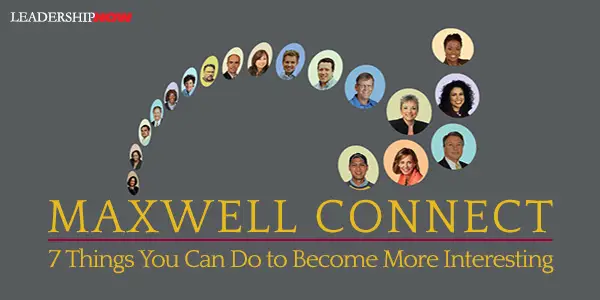
IF you want friends, show yourself friendly. If you want to connect with others, become the kind of person others want to connect with. Be the kind of communicator that you would like to hear. “Connectors,” says John Maxwell, “create an experience everyone enjoys.” A big part of being an interesting person is being interested in other people; making them feel interesting. You’ll be amazed at how interesting you become to them. In Everyone Communicates, Few Connect, Maxwell recommends seven things to make yourself more interesting. They were presented in the context of speaking to audiences, but as you will see, they have application to one-on-one communication as well.
“There are different ways that you can measure people's greatness. And the way I like to measure greatness is: How many people do you affect? In your time on earth, how many people can you affect? How many people can you make want to be better? Or how many people can you inspire to want to do what you do?” —Will Smith, Vanity Fair, July 1999
John Maxwell asks, “In the end, what good is our communication if its impact ends the moment we stop speaking?” 
Posted by Michael McKinney at 12:21 AM
06.16.10

Maxwell Connect: 4 Barriers to Finding Common Ground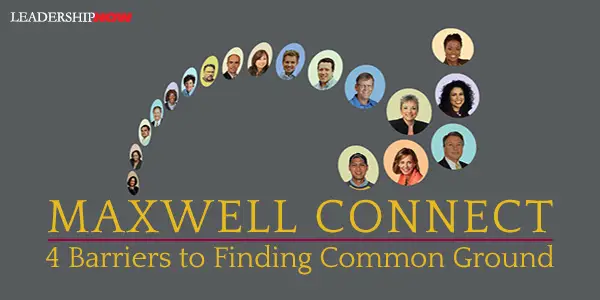
THE first rule of connecting is to find common ground. Again, this requires an other-focus. In Everyone Communicates, Few Connect, John Maxwell writes, “It is difficult to find common ground with others when the only person you are focused on is yourself!” We can’t find common ground if we are trying to make other people into a version of ourselves. Each of us sees the world from our own unique perspective. Terry Felber, author of Am I Making Myself Clear? There are many reasons people neglect to find common ground, Maxwell says, but here are the top four:
Taking down these barriers is a matter of choice. It means making yourself available, listening to others, asking questions, being open, being adaptable to people and situations, and most importantly, being humble. “I will think of myself less so I can think of others more.” Civil rights activist Cornel West says, “Humility means two things. One, a capacity for self-criticism…. The second feature is allowing others to shine, affirming others, empowering and enabling others. Those who lack humility are dogmatic and egotistical. That masks a deep sense of insecurity. They feel the success of others is at the expense of their own fame and glory.”

Posted by Michael McKinney at 07:34 AM
06.14.10

Maxwell Connect: Everyone Communicates, Few Connect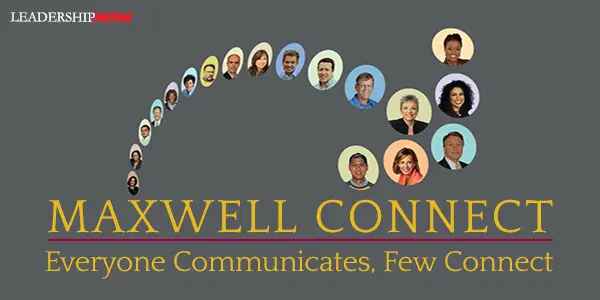
GEORGE BERNARD SHAW said, “The greatest problem in communication is the illusion that it has been accomplished.” How true. One of the biggest reasons leaders fail is their inability to communicate. Most of the time, we unconsciously leave it to chance. Just because we say something doesn’t mean we have communicated it. As John Baldoni observed, “The ability to speak is not the same thing as the ability to communicate….The capacity to construct a message, address it to another, listen for feedback, process that feedback, and continue to communicate in ways that are understood is one of the hardest things a leader will have to do.” But it can be done if we are willing to make the conscious choice to connect with others. John Maxwell has written a clear and well-organized book (with his writing partner Charlie Wetzel) about connecting with others one-on-one, in groups, and before an audience. It’s a practical book about bridging the gap between you and the people you are trying to connect with. Everyone Communicates, Few Connect is oriented towards leaders, which is to say, any of us that decide to make a choice to intentionally influence others. Connecting is basic to human relations. Maxwell puts it simply: “If you want to succeed, you must learn how to connect with others.” He asks, “Have you ever heard of someone who is said to have a charmed life? Usually, those are people who have learned how to connect. When you connect with others, you position yourself to make the most of your skills and talents.” How does connecting happen? Not surprisingly, it all begins with your attitude. “The ability to connect with others begins with understanding the value of people.” As with leadership in general, connecting is about other people. In a word, selflessness. It is about asking yourself, “Am I going to make this about them or me?” Maxwell points out that “understanding that your focus must be on others is often the greatest hurdle people face in connecting with others.” It’s all too easy to get caught up in what we are doing to the point where we place it and ourselves at the center of the universe. Maxwell writes, “Good teachers, leaders, and speakers don’t see themselves as experts with passive audiences they need to impress. Nor do they view their interests as most important. Instead, they see themselves as guides and focus on helping others learn.” He tells a story from when he began his career as a minister. He felt frustrated and unfulfilled. He kept asking himself questions like, “Why aren’t people listening to me? Why aren’t people helping me? Why aren’t people following me?” He writes, “Notice my questions centered on me because my focus was on me….I was self-absorbed, and as a result, I failed to connect with people….I realized that I was trying to get ahead by correcting others when I should have been trying to connect with others.” It is all too easy to focus on our needs instead of the needs of others. There are three questions people are always asking about you: “Do you care for me?” “Can you help me?” and “Can I trust you?”Connecting begins when the other person feels valued. We need to have the attitude and approach of “What can I do to increase my value of others?” The ideas he presents are not new nor should we expect them to be. While technology has changed some of our tools of communication, it has not changed the principles of connecting. Ironically, technology has not made it any easier or better. Today's technology won’t communicate a selfless attitude any better than using smoke signals if it is not the foundation of the communication in the first place. Forming connections with each other has not changed over time. We must always be reminded of the principles behind it. 
Posted by Michael McKinney at 11:59 AM

Stimulus Package 3 - Free Book: Everyone Communicates, Few Connect Here’s a stimulus package to get you thinking. It’s a package designed to serve as a catalyst to help you to find ways to make things work and get things done. While you might think of it as a piece of good fortune, don’t think of it as a bailout. You’ve still got to do the inside work. Here’s a stimulus package to get you thinking. It’s a package designed to serve as a catalyst to help you to find ways to make things work and get things done. While you might think of it as a piece of good fortune, don’t think of it as a bailout. You’ve still got to do the inside work.
In partnership with Thomas Nelson Publishers, we are giving away five copies of Everyone Communicates, Few Connect by John Maxwell. Everyone Communicates, Few Connect asks are you just talking or are you connecting. Connecting is the ability to identify with people and relate to them in a way that increases your influence with them. To be successful, Maxwell says, you must work with others. To do that at your absolute best, you must learn to connect. For a chance to receive a free copy, leave a comment by midnight, Sunday, June 20th, on this post about how you approach the need to connect. How has your ability to connect or not connect affected your ability to influence those around you either at work or in your personal life? On Monday, June 21, 2010 we will randomly select five recipients to receive a free copy.
Posted by Michael McKinney at 11:43 AM
06.10.10

Top Five Rules for Digital Marketing Success in an Anytime, Everywhere World
Rule #1: Insight Comes Before Inspiration. The most successful digital initiatives typically don't start with the idea for a cool new digital experience. Instead, they start with consumer insights culled from painstaking research into who your customers are, what they're all about, how they interact with consumer technologies, and what they want from the brands they know and trust. Case in point: Dove's "Campaign for Real Beauty." Rule #2: Don't Repurpose, Reimagine. Creating multi-platform strategies that connect with audiences where they live doesn't just mean posting television spots on YouTube in the hopes they go viral. In a medium where the possibilities are endless, television is the jumping-off point to much more interactive and engaging experiences. You've got to invent new ways to help your customers make your brand their own. Case in point: HBO's Voyeur Project. Rule #3: Don't Just Join the Conversation -- Spark It. Out of the over 600,000 branded pages that Facebook Page Tracker monitors, a mere 57,000 have more than 1,000 "fans." Apparently, most people don't want to be friends with a brand. If you want to be part of the conversation on social networking sites, be the party that initiates it -- through compelling experiences that keep customers talking. Case in point: Johnson & Johnson's BabyCenter. Rule #4: There's No Business Without Show Business. Your brand is a story; tell it. Don't just sell product; sell the problem it solves, the feeling it gives, the status it conveys, or the value it embodies. But beware of pushing to transform your brand's website into an "entertainment portal" simply for entertainment's sake. In the on-demand era, the best-branded entertainment experiences are P-O-S-itive -- that is: personalizable, ownable, and sharable. Case in point: Degree antiperspirant's webisode series "The Rookie." Rule #5: Want Control? Give It Away. "User-generated content" (UGC) might not be cutting edge (it's been featured on ABC-TV's America's Funniest Home Videos for nearly twenty years), but it's a big-time buzz builder. Young consumers, especially adolescent males, seem more than happy to create their own video ads to upload on YouTube and email to friends. How do you give away control while simultaneously getting what you want? Ensure rewards for making UGC promote your brand, rather than mock or bash it. Case in point: Doritos' $1 million contest for creating a Super Bowl commercial, which, according to the company, generated $36 million in free publicity for the brand before and after the big game. Adapted from The On-Demand Brand: 10 Rules for Digital Marketing Success in an Anytime, Everywhere World by Rick Mathieson. 
Posted by Michael McKinney at 10:32 AM
06.09.10

Why Design Thinking Is the Next Competitive Advantage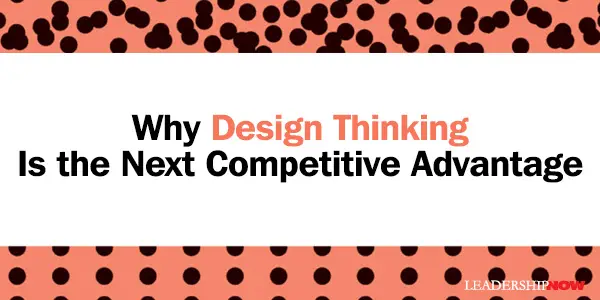
WE live in a reliability-oriented world. And understandably so. We want predictable outcomes. We want things to keep working as they have always been—perfectly. Success. Repeat. Success. Repeat. But that thinking ultimately limits our growth and quite possibly harbors the seeds of our own destruction. It can be (very) valuable to a point, but it isn’t adaptable because by its very nature it has to leave something out of the equation. While reliable outcomes “reduce the risk of small variations in your business, they increase the risk of cataclysmic events that occur when the future no longer resembles the past” and the reliable is no longer relevant or useful. To remain relevant—to foster innovation—you need to incorporate into your thinking outcomes that are valid. That is outcomes that produce a desired result even if the solution employed can’t produce a consistent, predictable outcome. A perfectly valid solution is one that produces a result that is shown, through the passage of time, to have been correct. It is best to have a system that incorporates both—validity and reliability—into their approach. Balancing and managing the two approaches—analytical and intuitive—is what design thinking is all about. In The Design of Business, Roger Martin presents the knowledge funnel to show how knowledge moves. Each stage represents a simplification and ordering of knowledge. At the beginning is a mystery; a question. It is the observation of phenomena. Things we see but don’t yet understand.
The next stage is a heuristic, “a rule of thumb that helps to narrow the field of inquiry and work the mystery down to a manageable size.” Heuristics don’t guarantee success but do increase the probability of success. The last stage is the development of an algorithm. “An algorithm is an explicit, step-by-step procedure for solving a problem. Algorithms take the loose, unregimented heuristics—which take considerable thought and nuance to employ—and simplify, structuralize, and codify them to the degree that anyone with access to the algorithm can deploy it with more or less equal efficiency.” Martin uses the example of the development of McDonalds to illustrate how they proceeded down the knowledge funnel. In 1940 the McDonald brothers opened their first drive-in restaurant in San Bernardino, California. It did well, but by 1950 they began to lose business. Food was getting cold before it was delivered and families were put off by the hoards of teenagers they attracted. They had to develop a winning heuristic. They reduced and standardized the menu, and implemented their Speedee Service System. Ray Kroc saw an opportunity in it and bought them out. While the Speedee Service System was good, Kroc thought it left too much to chance. So he refined it and simplified it down to an exact science. The new system left nothing to chance and it was repeatable. “Kroc relentlessly stripped away uncertainty, ambiguity, and judgment from the processes that emerged from the McDonald brothers’ original insight. And by fine-tuning the formula, he powered McDonald’s from a modestly prosperous chain of burger restaurants to a scale previously undreamed-of.” The problem is getting stuck in any one stage. We tend to operate within a knowledge stage as opposed to moving across the knowledge stages. We need to explore and question, we need to exploit our solutions, even reducing them to a repeatable, efficient, formula where possible, but we need to be doing these things simultaneously. The vast majority of businesses follow a common path. The company is birthed through a creative act that converts a mystery to a heuristic through intuitive thinking. It then hones and refines that heuristic through increasingly pervasive analytical thinking and enters a long phase in which the administration of business dominates. And in due course, a competitor stares at the mystery that provided the spark for this company, comes up with a more powerful heuristic, and supplants the original business. McDonalds did well for decades, but eventually the heuristic (Americans want a quick, convenient, tasty meal) changed (Americans want a healthier menu). The solution for McDonalds is to go back and rethink the mystery and develop new rules of thumb to guide them. A trip back through the knowledge funnel. Avoiding this cycle is the job of the leader—a leader at any level. Martin writes, “CEOs must learn to think of themselves as the organization’s balancing force—the promoter of both exploitation and exploration; of both administration and invention.” This is design thinking. We need to develop our design thinking skills, analyze what’s working and why, and at the same time revisit the original mystery while considering entirely new mysteries. “The design thinker develops the capacity for observation, for seeing features that others may miss. The design thinker, in the words of novelist Saul Bellow, is ‘a first-class noticer.’” Always cycling through the knowledge funnel.
Posted by Michael McKinney at 12:28 PM
06.08.10

5 Leadership Lessons: Getting Your Leadership in Gear Rhett Laubach has written a book to help you get your leadership in gear. Leaders in Gear is filled with 37 practical behaviors, strategies and tactics to lead yourself and others and 22 ideas to improve your presentations.
Posted by Michael McKinney at 12:48 PM
06.07.10

John Wooden: It Takes a lot of Strength on the Inside to be Gentle on the Outside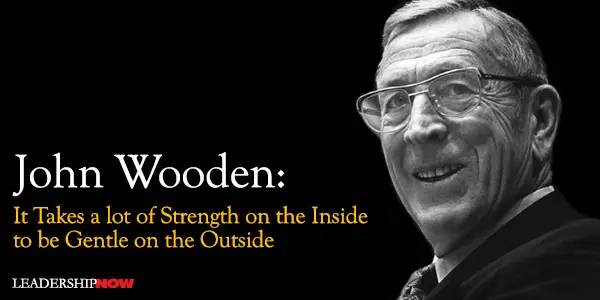
I FIRST MET John Wooden (October 14, 1910 – June 4, 2010) in the early eighties when working on a presentation product for his pyramid of success. He truly was a legendary teacher who based his life on sound principles. As with nearly everyone he came into contact with, he had a positive influence. Not surprisingly, his Dad, Joshua Wooden, took the time to lay a firm foundation for him. Upon his graduation from Centerton Grade School, his Dad gave him a card with seven suggestions to follow:
In his book, The Essential Wooden, John Wooden tells a story of his Dad’s leadership to illustrate the point that it takes a lot of strength on the inside to be gentle on the outside. It’s a good lesson for all of us: Scattered around the farmland where I grew up in Centerton, Indiana, were gravel pits. The county would pay local farmers to take a team of mules or horses into a pit and haul out loads of gravel for use on Morgan County roads. Some of the pits were deeper than others, and it would be tough for a team to pull a wagon filled with gravel out through the wet sand and up a steep incline. 
Posted by Michael McKinney at 12:50 PM
06.02.10

Are You Leading Creatively?The new economy brings with it new demands. New ways of thinking. New ways of communicating. “The world is spinning faster,” said a Government CEO in Australia. “We need to keep pace.”In the face of complexity and uncertainty, over 1500 CEOs interviewed in a study conducted by IBM, said that creativity was the leadership quality they valued most. Creativity: “the basis for “disruptive innovation and continuous re-invention”—new risks, new ideas, new ways of influencing and communicating. “Creative leaders invite disruptive innovation, encourage others to drop outdated approaches, and take balanced risks. They are open-minded and inventive in expanding their management and communication styles, particularly to engage with a new generation of employees, partners and customers.” CEOs are looking or a significant shift. IBM’s Global Chief Executive Officer Study asks:
Of Related Interest:
Posted by Michael McKinney at 01:46 AM
06.01.10

First Look: Leadership Books for June 2010Here's a look at some of the best leadership books to be released in June.




For bulk orders call 1-800-423-8273  Build your leadership library with these specials on over 160 titles. All titles are at least 40% off the list price and are available only in limited quantities.
Posted by Michael McKinney at 08:52 AM
|
BUILD YOUR KNOWLEDGE


How to Do Your Start-Up Right STRAIGHT TALK FOR START-UPS 
Grow Your Leadership Skills NEW AND UPCOMING LEADERSHIP BOOKS 
Leadership Minute BITE-SIZE CONCEPTS YOU CAN CHEW ON 
Classic Leadership Books BOOKS TO READ BEFORE YOU LEAD |
| ||||||||||||||||||||||||||